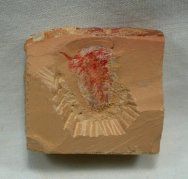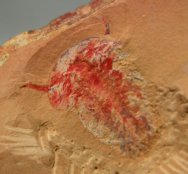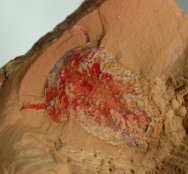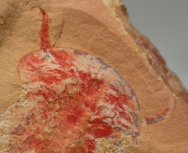| 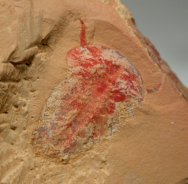 Description:
The exact taxonomic status of this arthropod is in dispute. It has
been termed a “trilobitomorph” by some researchers,
showing their beliefs in its close affinity with the trilobites.
While the Trilobitoorpha was listed in the Treatise, most now consider
that this subphylum is invalid, a catchall much like some of the
dustbin terms used by Walcott for a number of the Burgess Shale
fauna. Whittington termed it a “soft-bodied trilobite”’
but that belief is not supported at present. Their similarity in
appearance to the Agnoistida is purely a result of convergence.
Two large groupings of the Paleozoic arthropods are currently in
favor: the Crustaceomorpha (which includes Waptia) and the Arachnomorpha,
dominated by the trilobites. The Naraoiidae are arachnomorphs and
include Misszhouia and Naraoia. Misszhouia longicaudata was initially
placed within Naraoia, but was given its own genus based upon differences
between it and Naraoia compacta of the Burgess Shale. Description:
The exact taxonomic status of this arthropod is in dispute. It has
been termed a “trilobitomorph” by some researchers,
showing their beliefs in its close affinity with the trilobites.
While the Trilobitoorpha was listed in the Treatise, most now consider
that this subphylum is invalid, a catchall much like some of the
dustbin terms used by Walcott for a number of the Burgess Shale
fauna. Whittington termed it a “soft-bodied trilobite”’
but that belief is not supported at present. Their similarity in
appearance to the Agnoistida is purely a result of convergence.
Two large groupings of the Paleozoic arthropods are currently in
favor: the Crustaceomorpha (which includes Waptia) and the Arachnomorpha,
dominated by the trilobites. The Naraoiidae are arachnomorphs and
include Misszhouia and Naraoia. Misszhouia longicaudata was initially
placed within Naraoia, but was given its own genus based upon differences
between it and Naraoia compacta of the Burgess Shale.
The
species is one found in several locations within Yunnan Province,
but this one is from the most famous location of all, Maotianshan,
site of the 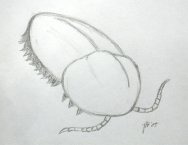 discovery
of the Chegjiang Biota by Hou Xian-guang in 1984. Indeed, it is
this taxon which was first discovered at Maotianshan to start the
entire cycle of research. The diversity of soft-tissue fossils is
astonishing: algae, medusiforms, sponges, priapulids, annelid-like
worms, echinoderms, arthropods (including trilobites), hemichordates,
chordates, and the first agnathan fish make up just a small fraction
of the total. Numerous problematic forms are known as well, some
of which may have represented failed attempts at diversity that
did not persist to the present day. discovery
of the Chegjiang Biota by Hou Xian-guang in 1984. Indeed, it is
this taxon which was first discovered at Maotianshan to start the
entire cycle of research. The diversity of soft-tissue fossils is
astonishing: algae, medusiforms, sponges, priapulids, annelid-like
worms, echinoderms, arthropods (including trilobites), hemichordates,
chordates, and the first agnathan fish make up just a small fraction
of the total. Numerous problematic forms are known as well, some
of which may have represented failed attempts at diversity that
did not persist to the present day.
This
one shows many of the classic features of the taxon, with most of
the soft cuticle, a few legs, and the antennae preserved. Even if
it is not a true trilobite, it is sure to be a coveted addition
to any collection, one of historical significance due to its ties
with the discovery location of the Chengjiang Biota. What makes
this one even more unusual is the fact that portions of the anatomy
other than the cuticle are not commonly seen.
|


